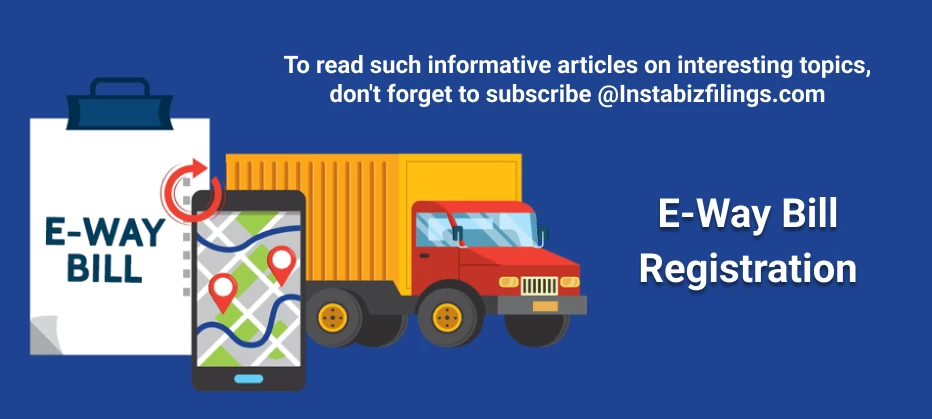
E-Way Bill Registration
January 23, 2025 by Team Instabizfilings
The E-Way Bill is a basic component of India's Goods and Services Tax (GST) system. This bill enables the smooth transportation of goods and ensures that there is proper tax compliance right from the supply chain level. E-Way Bill Registration is the first step toward preparing an E-Way Bill and is required if a business or merchant transfers goods across a state or location.
What is an E-Way Bill?
An E-Way Bill is a document generated online on the GST portal, i.e., www.gst.gov.in, for transportation of goods. It contains description, quantity, value, and all the details regarding the consignor/consignee details. The proof of compliance to the GST Act is an E-Way Bill that accompanies the transport of goods.
This has emerged in light of an E-Way Bill so as to eradicate tax evasion, while allowing easy passage of commodities between Indian states. The limit of this criterion applies in all the instances of more than ₹50,000 either intrastate or interstate.
When is E-Way Bill Registration Required?
E-Way Bill registration is needed when:
-
Goods are being transported: If goods worth more than ₹50,000 are being transported from one place to another (within or outside a state).
-
Inter-state or Intra-state movement: It applies both to inter-state that is movement across the states and intra-state that is movement within the same state.
-
Supply, sale, or purchase: An E-Way Bill is required if the goods are being supplied, sold, or purchased.
-
Goods exceed ₹50,000 in value: The goods being transported are valued over ₹50,000 (exclusive of taxes).
Prerequisites for E-Way Bill Registration
All of these must be confirmed before registration to the E-Way Bill:
-
GST Registration: GST requires the registration of the business. The GSTIN (a GST Identification Number) is assigned for generating an E-Way Bill.
-
Transportation Details: You will be needing information regarding the name of the transporter, number of vehicles and consignment details.
-
Valid GSTIN: Ensure that the GSTIN is active and operational for the generation of E-Way Bill.
How to Register for an E-Way Bill?
The steps involved in E-Way Bill registration are as follows:
- Step 1: Visit the E-Way Bill Portal
-
Open the E-Way Bill portal at www.ewaybillgst.gov.in.
- Step 2: Log in Using GSTIN
-
You will need to enter your GSTIN and password to login. If you don't have an account, you will first need to register on the portal.
- Step 3: Go to the Registration Section
-
After login, click on the "Registration" option on the main menu.
- Step 4: Fill Out the Registration Form
-
Enter required details such as your GSTIN, Business name, State, and other required information.
-
Verify that all information entered is correct to avoid any issues during the registration process.
- Step 5: Submit the Registration Form
-
After filling all the details, click on "Submit" to complete the registration process.
- Step 6: Generate E-Way Bill
-
Once the user is successfully registered, then you can make e-way bills for the movement of goods. Under the menu heading Generate E-way bill, fill all the information details such as the consignor, consignee, and description of the goods with all the information required for the transporters.
Information Required for Generating an E-Way Bill
Once you sign up, you can create an E-Way Bill on the basis of the following information:
-
GSTIN of Consignor and Consignee: GSTIN number of sender and receiver
-
Invoice or Challan Number: Number of invoice or challan from which the item to be transferred is associated.
-
Goods Description: A short description of these goods to be delivered.
-
Quantity and Value: The number of goods along with its value including tax end.
-
Mode of Transport: Whether transport is by road, rail, air, or ship.
-
Transporter Details: The name of the transporter including number of vehicle number in case of road transport; transporter ID if it is either rail,air or ship mode.
Types of E-Way Bills
There are different types of E-Way Bills based on the nature of the transaction:
-
E-Way Bill for Supply: To be generated in cases of supply or sale.
-
E-Way Bill for Return: When the goods are to be returned.
-
E-Way Bill for Stock Transfer: This is generated while transferring goods within the same business under different branches or locations.
-
E-Way Bill for Job Work: Used when goods are being sent for job work and brought back.
Validity of E-Way Bill
The validity of an E-Way Bill depends on the distance that the goods need to travel. Here are the details:
-
For road transport: The validity is determined based on the distance the goods travel.
- Up to 100 km: Valid for 1 day.
- For every 100 km or part thereof: The validity period increases by 1 day.
-
For rail, air, and ship transport: The validity is determined based on the distance and mode of transport.
The E-Way Bill can be extended if it expires before the goods reach their destination.
How to Track the E-Way Bill?
Once the E-Way Bill is generated, the following are the steps by which the businesses can track:
-
Login to the E-Way Bill portal.
-
Click on the option: "Track E-Way Bill".
-
Enter the E-Way Bill Number (EBN) to view details of the consignment.
The portal will present the information related to transportation. This will cover the current status and the estimated time of delivery.
Penalties for Non-Compliance
Failure to produce an E-Way Bill or improper documentation may cause penalties as follows:
-
Penalty under GST: In case goods are transported without a valid E-Way Bill or an E-Way Bill not updated, a penalty of ₹10,000 or the amount of tax evaded, whichever is higher.
-
Seizure of Goods: In case no E-Way Bill is generated or the actual goods being transported does not match, the authorities have the right to seize the goods.
Important Tips for E-Way Bill Registration and Compliance
-
Ensure GST Registration: Ensure that the GST registration is active and current for the generation of the E-Way Bill to avoid any inconveniences.
-
Timely Generation: Always generate the E-Way Bill before dispatching goods to avoid penalties.
-
Correct Information: Information entered in E-Way Bill should be cross-checked, especially for the transporter, vehicle number, and invoice number.
-
Renew E-Way Bills: In case the E-Way Bill expires during transit, renew it to avoid harassment from the authorities.
Conclusion
E-Way Bill Registration and generation is an essential process of GST compliance for any business that transports goods. This ensures that goods move freely, while there is transparency and reduced possibilities of tax evasion. Thus, by following the steps of registration and the correct generation of an E-Way Bill, businesses can easily follow the GST regulations and avoid penalties.
Never forget that time and accuracy of filing are necessary to ensure the easy transportation of goods within India.
Disclaimer
The information provided in this blog is purely for general informational purposes only. While every effort has been made to ensure the accuracy, reliability and completeness of the content presented, we make no representations or warranties of any kind, express or implied, for the same.
We expressly disclaim any and all liability for any loss, damage or injury arising from or in connection with the use of or reliance on this information. This includes, but is not limited to, any direct, indirect, incidental, consequential or punitive damage.
Further, we reserve the right to make changes to the content at any time without prior notice. For specific advice tailored to your situation, we request you to get in touch with us.


